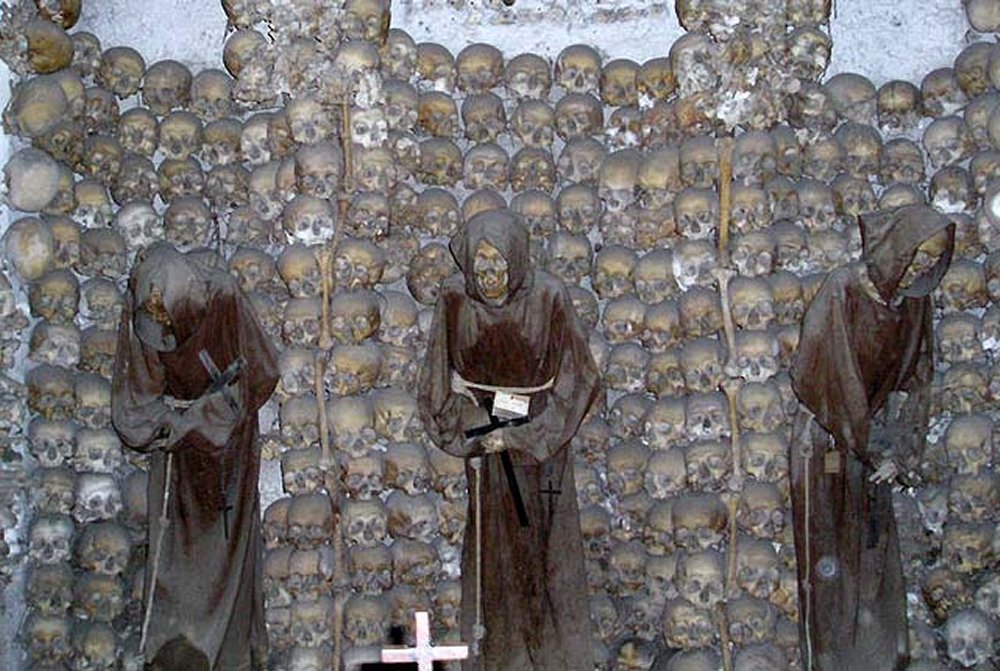Bizarre Ancient Capuchin Crypt ‘Decorated’ With The Bones Of 4,000 Monks
A. Sutherland – MessageToEagle.com – Under the city of Rome, there is a maze of long-forgotten ancient passages and temples; there are millennia-old underground burial chambers, which remember times when Christianity was only a forbidden cult and its members were executed as pagans and buried as martyrs.
One of the most original and eerie places in the underground realm of Rome is the Capuchin Crypt also known as the ‘Bone Chapel’.

The Capuchin Crypt is a very special place with the remains of 4,000 Capuchin monks buried by their order. Their standing and dressed in robes skeletons, are staring from the walls and in the background, there are hundreds of anonymous skulls of those who died long ago.
They ‘decorate’ the underground crypt with vertebrae chandeliers, skulls of real size and cross-bones.

The Capuchin Crypt with several small chapels is located beneath the church of Santa Maria della Concezione dei Cappuccini, in Rome, Italy and it comprises of six rooms filled with the bodies of friars who died between 1528 and 1870.
On one of the chapel’s wall there is written in three languages,
“What you are now, we once were; what we are now, you shall be.”
Probably it has never been an intention to display strange place and its atmosphere as a macabre, but rather to remind of the passage of time, which takes lives with it. Still, the crypt is by many considered a morbid underground realm of death.

Arthur B. Frommer, a travel writer, and author of a series of travel guides wrote about the crypt:
“one of the most horrifying images in all of Christendom”, large numbers of the bones are nailed to the walls in intricate patterns. Many are piled high among countless others, while others hang from the ceiling as light fixtures…”
When the monks arrived at the church in 1631, they brought 300 cartloads of deceased friars. Fr. Michael of Bergamo oversaw the arrangement of the bones in the burial crypt. The soil in the crypt was brought from Jerusalem, by order of Pope Urban VIII.

As monks died during the lifetime of the crypt, the longest-buried monk was exhumed to make room for the newly-deceased and so, it continued.
The newly-retrieved bones were immediately used as a ‘decoration’.
The dead monks’ bodies usually spent 30 years in the soil during the process of decomposition, before being exhumed.
The crypt had its beginnings in ancient times when a cult for a dead – rooted in Catholicism, but also closely associated with the cult of the dead of Greece and Rome – was flourishing.
Written by – A. Sutherland – MessageToEagle.com Senior Staff Writer
Copyright © MessageToEagle.com All rights reserved. This material may not be published, broadcast, rewritten or redistributed in whole or part without the express written permission of MessageToEagle.com
Expand for referencesRelated Posts
-
 Great Living Chola Temples: Outstanding Workmanship Of Chola Dynasty Builders Of South India
No Comments | Jul 29, 2024
Great Living Chola Temples: Outstanding Workmanship Of Chola Dynasty Builders Of South India
No Comments | Jul 29, 2024 -
 Figurine Of Mythical Individual Dates Back To Egypt’s Naqada Culture 4400–3000 BC
No Comments | Dec 4, 2016
Figurine Of Mythical Individual Dates Back To Egypt’s Naqada Culture 4400–3000 BC
No Comments | Dec 4, 2016 -
 “Altar Of Twelve Gods” At Gabii, Italy Was Once An Important Ancient Place
No Comments | Dec 15, 2015
“Altar Of Twelve Gods” At Gabii, Italy Was Once An Important Ancient Place
No Comments | Dec 15, 2015 -
 1.5 Million-Year-Old Human Vertebra Discovered In Israel’s Jordan Valley Sheds New Light On Migration From Africa To Eurasia
No Comments | Feb 3, 2022
1.5 Million-Year-Old Human Vertebra Discovered In Israel’s Jordan Valley Sheds New Light On Migration From Africa To Eurasia
No Comments | Feb 3, 2022 -
 Mystery Of Ancient Gaza Wine – New Insight
No Comments | Apr 27, 2023
Mystery Of Ancient Gaza Wine – New Insight
No Comments | Apr 27, 2023 -
 Dispute And Mystery: Strange Case Of The Tomb KV55 In The Valley Of Kings, Egypt
No Comments | Oct 8, 2015
Dispute And Mystery: Strange Case Of The Tomb KV55 In The Valley Of Kings, Egypt
No Comments | Oct 8, 2015 -
 Ancient Cave Church Complex In Basarabi, Romania
No Comments | Mar 10, 2016
Ancient Cave Church Complex In Basarabi, Romania
No Comments | Mar 10, 2016 -
 Valkyries Sigrdriva And Brynhildr: Brave Warriors Who Were Punished By God Odin In Norse And Germanic Mythology
No Comments | Apr 4, 2017
Valkyries Sigrdriva And Brynhildr: Brave Warriors Who Were Punished By God Odin In Norse And Germanic Mythology
No Comments | Apr 4, 2017 -
 DNA Sheds New Light On The Mysterious Dead Sea Scrolls
No Comments | Jun 2, 2020
DNA Sheds New Light On The Mysterious Dead Sea Scrolls
No Comments | Jun 2, 2020 -
 Legendary Ynglings: Descendants Of The Norse Gods And Oldest Scandinavian King Dynasty
No Comments | Mar 14, 2023
Legendary Ynglings: Descendants Of The Norse Gods And Oldest Scandinavian King Dynasty
No Comments | Mar 14, 2023
